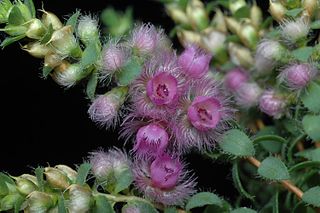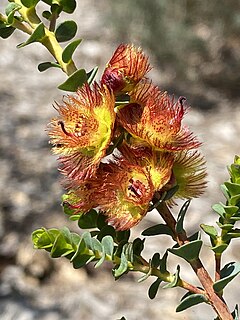Verticordia forrestii, commonly known as Forrest's featherflower, is a flowering plant in the myrtle family, Myrtaceae and is endemic to the north-west of Western Australia. It is a shrub with small, egg-shaped leaves and massed displays of scented pink to red flowers in spring.

Verticordia grandis is a large woody shrub that occurs in Southwest Australia. The name grandis, Latin for large, is a reference to its large flowers, leaves, and height. It is well known for its large flowers, which are collected and cultivated, and given the informal name of scarlet featherflower. It was the first species of the family Myrtaceae to have been genetically modified.
Verticordia albida is a flowering plant in the myrtle family, Myrtaceae and is endemic to the south-west of Western Australia. It is a shrub with one main stem with many branches and spike-like groups of scented, white feathery flowers with a pink centre.
Verticordia aereiflora is a flowering plant in the myrtle family, Myrtaceae and is endemic to the south-west of Western Australia. It is a thin but bushy shrub with small leaves and greenish-yellow flowers with red spots and red fringes on the sepals.
Verticordia argentea is a flowering plant in the myrtle family, Myrtaceae and is endemic to the south-west of Western Australia. It is an erect, open shrub with almost circular leaves and scented, pink and white flowers. It usually grows in sand and is found near Eneabba.

Verticordia blepharophylla is a flowering plant in the myrtle family, Myrtaceae and is endemic to the south-west of Western Australia. It is an erect, open shrub with a single main stem, leaves with hairy margins and pale to deep mauve-pink flowers and which occurs in an area between Perth and Geraldton.
Verticordia capillaris is a flowering plant in the myrtle family, Myrtaceae and is endemic to the south-west of Western Australia. It is a shrub with a single stem at the base, small leaves and creamy white or occasionally pink flowers in dense corymb-like groups. It is common in small areas near Geraldton.
Verticordia sect. Pennuligera is one of six sections in the subgenus Eperephes. It includes sixteen shrub species in the genus Verticordia. Plants in this section range from small and spreading to large shrubs and have been referred to as "lettuce-leaved" or "round-leaved". The flowers are relatively large, with their sepals having feathered lobes and ear-like appendages on a stalk so that the appendages cover the floral cup. The petals are oval to egg-shaped or round and are usually fringed.

Verticordia halophila, commonly known as salt-loving featherflower, or salt-loving verticordia, is a flowering plant in the myrtle family, Myrtaceae and is endemic to the south-west of Western Australia. It is an erect, bushy shrub with small, crowded, thick leaves and spikes of red and pink flowers in spring.

Verticordia monadelpha is a flowering plant in the myrtle family Myrtaceae, and is endemic to the south-west of Western Australia. It is a much-branched shrub with pink to magenta flowers in spring and early summer. It is commonly known as pink Morrison, woolly featherflower, pink woolly featherflower, white woolly featherflower or pink cauliflower.

Verticordia chrysostachys is a flowering plant in the myrtle family, Myrtaceae and is endemic to the south-west of Western Australia. It is an open-branched shrub with egg-shaped to almost circular leaves, and spike-like groups of cream-coloured or deep yellow flowers.
Verticordia comosa is a flowering plant in the myrtle family, Myrtaceae and is endemic to the south-west of Western Australia. It is an openly branched shrub with small, broad, almost round leaves and spikes of flowers that are pale yellow, sometimes with a white or pale pink centre.

Verticordia dichroma is a flowering plant in the myrtle family, Myrtaceae and is endemic to the south-west of Western Australia. It is a much-branched shrub with rounded leaves and spikes of scented, deep red and golden-coloured flowers.

Verticordia etheliana is a flowering plant in the myrtle family, Myrtaceae and is endemic to the south-west of Western Australia. It is a shrub with one highly branched main stem, egg-shaped to almost round leaves and spike-like groups of bright red flowers with greenish-cream centres.
Verticordia etheliana var. etheliana is a flowering plant in the myrtle family, Myrtaceae and is endemic to the south-west of Western Australia. It is a shrub with one highly branched main stem, egg-shaped to almost round leaves and spike-like groups of bright red flowers with greenish-cream centres. It differs from V. etheliana var. formosa in having longer leaves, and larger flowers.
Verticordia etheliana var. formosa is a flowering plant in the myrtle family, Myrtaceae and is endemic to the south-west of Western Australia. It is a compact shrub similar to var. etheliana but with smaller leaves and flowers.
Verticordia fragrans, commonly known as hollyhock verticordia, is a flowering plant in the myrtle family, Myrtaceae and is endemic to the south-west of Western Australia. It is an openly branched shrub with egg-shaped leaves and spikes of sweetly scented, pink and white flowers in spring and early summer.
Verticordia lepidophylla is a flowering plant in the myrtle family, Myrtaceae and is endemic to the south-west of Western Australia. It is usually a bushy shrub with small leaves and spikes of creamish-green to yellow flowers in spikes along the branches in late spring to early summer.
Verticordia muelleriana is a flowering plant in the myrtle family, Myrtaceae and is endemic to the south-west of Western Australia. It is an openly branched shrub with relatively large, egg-shaped to circular leaves and long spikes of deep maroon coloured flowers in spring and early summer.
Verticordia × eurardyensis, commonly known as Eurardy magenta, is a flowering plant in the myrtle family, Myrtaceae and is endemic to a small area in the south-west of Western Australia. It is a shrub similar to both Verticordia dichroma and Verticordia spicata which grow in the same area and is thought to be a stable hybrid between those two species. It has mostly egg-shaped leaves and spike-like groups of dark magenta-coloured flowers which fade to straw-coloured, in late spring and early summer.







